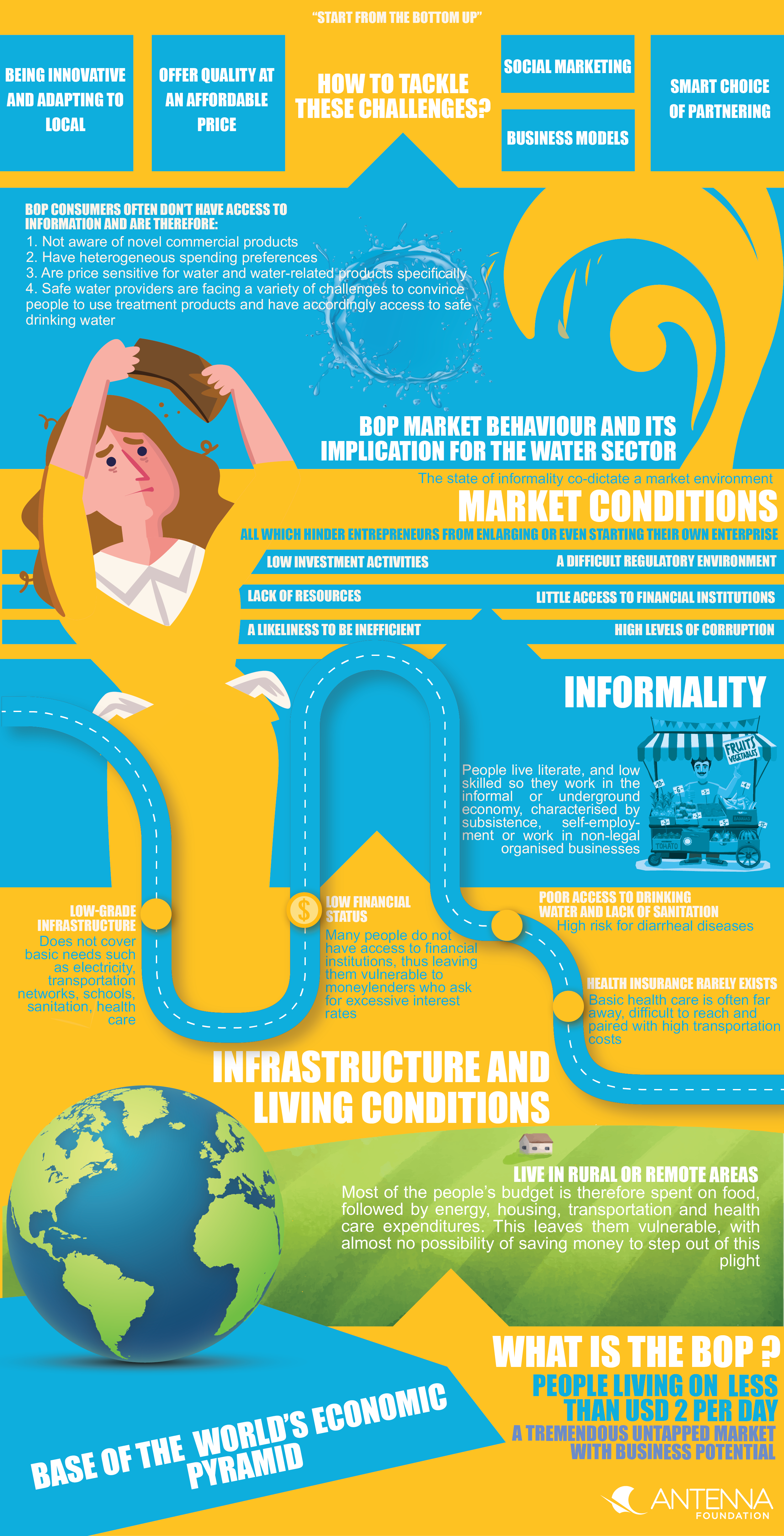Executive Summary

This background factsheet explains to the reader the concept of "base (or bottom) of pyramid" and how it has become a valuable and helpful business concept.
What is the BoP and does it comprise?
The ground-breaking concept of the bottom of the economic pyramid (BoP) has been introduced by PRAHALAD AND HART in 1998. The innovative concept identifies people living at the bottom of the world’s economic pyramid as a tremendous untapped market with business potential. The two inventors propose that poor people living with only a few dollars daily (less than USD 2 per capita and day to an annual per capita income of less than USD 1500) should be seen as potential customers with substantial cumulated purchasing power and not as recipients of development aid. Including these people in formal markets, as entrepreneurs, producers and consumers will generate income and improve living conditions sustainably (PRAHALAD 2002).
Infrastructure and living conditions
The majority of people that comprise the BoP live in rural or remote areas, characterised by low-grade infrastructure that does not cover basic needs such as electricity and transportation networks, telecommunication, schools, sanitation, health care, etc. Bad infrastructure has several constraining implications. Many people at the BoP are not able to obtain bank accounts and do not have access to financial institutions, thus leaving them vulnerable to moneylenders who ask for excessive interest rates. People are, by majority, living in basic dwellings with poor access to drinking water and lack of sanitation, putting them at high risk for diarrheal diseases. Health insurance rarely exists; basic health care is often far away, difficult to reach and paired with high transportation costs. The meagre transportation networks limit market access for products and services, which causes higher prices and lower quality goods and services than those available for more affluent people in more developed regions. Most of the people’s budget is therefore spent on food, followed by energy, housing, transportation and health care expenditures. This leaves them vulnerable, with almost no possibility of saving money to step out of this plight.
Informality
The lack of possibilities to attend school and to attain professional education leaves people poorly literate and low skilled and makes it necessary for them to work and operate in the informal or underground economy, characterised by subsistence, self-employment or work in not legal organised businesses. Without job contracts “employees” are on the edge of exploitation, violence and insecurity, bringing limited and unsteady incomes with daily or weekly wages. As self-supporters, people are dependent on soil and weather and therefore highly vulnerable to natural catastrophes leaving their sources of food unpredictable and insecure. Addressing these issues with the creation of inclusive business approaches, offering sustainable products while engaging the local labour force is one solution to mitigate these severe living conditions. Market conditions however, are not always facilitating this endeavour.
Market conditions
The state of informality co-dictate a market environment, which is characterised by low investment activities, a difficult regulatory environment, lack of resources, little access to financial institutions, and a likeliness to be inefficient. This situation has its origins often in an outdated or weak legal framework that is prohibitive and requests numerous steps to receive legal permissions to start a business. The extensive level of bureaucracy is often paired with high levels of corruption and nepotism. These challenges often hinder entrepreneurs from enlarging or even starting their own enterprise. If entrepreneurs are able to establish a legal business, they face further obstacles. For illiterate and low educated entrepreneurs, it is often difficult to establish commercial relationships and grow because of missing market information on prices, demand and consumer behaviour.
BoP market behaviour and its implication for the water sector
BoP consumers often don’t have access to information and are therefore not aware of novel commercial products, have heterogeneous spending preferences and are price sensitive for water and water-related products specifically. Due to lacking information, low education and prevalent traditions of perceiving water as safe if not turbid, safe water providers are facing a variety of challenges to convince people to use treatment products and have accordingly access to safe drinking water. On top of that, circumstances of financial unpredictability, lack of infrastructure (roads, electricity, regulations etc.), limited market access and informality make doing business challenging. These challenges call for different strategies to reach BoP markets, especially also in the water sector.
Not only small initiatives are trying to reach people at the BoP with safe water, also several multinational enterprises (MNEs), either leveraged by corporate responsibility or striving for untapped markets, have entered these environments with somewhat limited success (e.g. TATA with TATASwach or P&G with PUR sachets). Given the market conditions at the BoP, the question remains how enterprises can successfully enter the BoP serving the poor.
Subscribe here to the new Sanitation and Water Entrepreneurship Pact (SWEP) newsletter. SWEP is a network of organizations joining hands to help entrepreneurs design and develop lasting water and sanitation businesses.
How to tackle these challenges?
There is no single right answer to how to reach the BoP, hence the following is some food for thought that can be adapted to individual contexts and cases. First of all, it is important to step out of the box and go beyond established business thinking by being innovative and adapting to local. Key factors that have to be reassessed include the value propositions (products and services), distribution channels, supply chains, prices and networks.
A product or service that shall be marketed to the BoP has to comply with the needs of local consumers, has to be accepted and offer quality at an affordable price. As consumers at the BoP are price sensitive and not eager to buy low-quality products using their spare money, producers have to offer innovative and aspirational products and services matching quality at affordable prices. Hence entrepreneurs need a willingness to invest in new approaches as well as infrastructure to develop feasible treatment products and services that improve people’s living condition and value of life. (Compare also with HCD).
Due to the fact that information channels are scarce, people often do not know about new products. The process of introducing and marketing new products is therefore essential and can be achieved by awareness creation through social marketing and consumer education e.g. with product demonstrations, door-to-door campaigns, word-of-mouth promotion and the involvement of local groups and networks.
Entrepreneurs have to develop solid business models to be able to distribute their products or services at affordable prices. The so-called last mile delivery is very costly and a major challenge to be overcome with innovative ideas or smart choice of partnering with existing supply chains. One possibility is sourcing for local knowledge or partnering with local businesses or organisations and governments to reach the poorest.
This Safe Water Business Perspective provides detailed insights on how challenges can be tackled and presents lessons learnt from the ground to avoid mistakes made and shall inspire for innovation.
Resources and governance in “base of the pyramid”- partnerships: Assessing collaborations between businesses and non-business actors
The Ethical Rational of Business for the Poor - Integrating the Concepts Bottom of the Pyramid, Sustainable Development, and Corporate Citizenship
The next 4 billion. Market size and business strategy at the Base of the Pyramid
Marketing Safe Water Systems: Why it is so hard to get safe water to the poor – and so profitable to sell it to the rich
This book provides unique insights – from the varied perspectives of users, disseminators, producers and retailers – into the marketing challenges of point-of-use water treatment devices.
HEIERLI, U. (2008): Marketing Safe Water Systems: Why it is so hard to get safe water to the poor – and so profitable to sell it to the rich. Bern: Swiss Agency for Development and Cooperation (SDC) URL [Accessed: 18.05.2019]Access to Safe Water for the Base of the Pyramid – Lessons Learned from 15 Case Studies
The book provides insights on how innovative approaches led by social entrepreneurs, NGOs, and corporations have proven that sustainable solutions could provide safe water at the Base of the Pyramid. To illustrate these findings 15 case studies are provided of innovative social enterprises active in Africa and Asia.
HYSTRA (2011): Access to Safe Water for the Base of the Pyramid – Lessons Learned from 15 Case Studies. Hybrid Strategies Consulting URL [Accessed: 16.04.2018] PDFThe Fortune at the Bottom of the Pyramid: Eradicating Poverty through Profits
The Fortune at the Bottom of the Pyramid
Profitable Business Models and Market Creation in the Context of Deep Poverty: A Strategic View
The Operational Guide for the Making Markets Work for the Poor (M4P) Approach
Frugal Innovation and Analogies: Some Propositions for Product
Partnerships for Inclusive Business Development
This publication provides the key definitions and concepts needed to understand low-income groups (referred to as the Base of the Pyramid) and partnerships with inclusive business.
PPPLAB (2015): Partnerships for Inclusive Business Development. URL [Accessed: 07.03.2018]Maturity Diagnostic - Business Call to Action
See to what extend your enterprise is really engaging with the BoP as an inclusive business and what you can potentially change in order to reach more BoP consumers.


